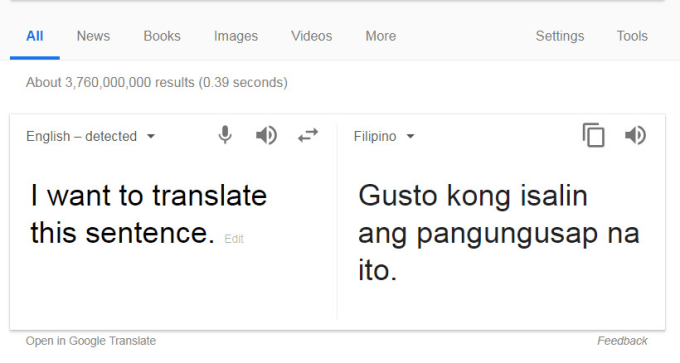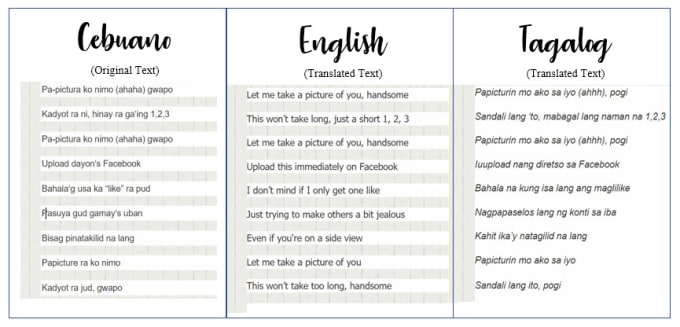
- ACCURATE ENGLISH TO TAGALOG TRANSLATOR DRIVER
- ACCURATE ENGLISH TO TAGALOG TRANSLATOR SOFTWARE
- ACCURATE ENGLISH TO TAGALOG TRANSLATOR PROFESSIONAL
Although these systems aren’t perfect, learning from these could be a start.
ACCURATE ENGLISH TO TAGALOG TRANSLATOR PROFESSIONAL
When they detect poor quality in the translated texts, the texts are automatically routed to professional editors. For example, Unbabel and Kantan are platform plugins that businesses add into their customer support and marketing workflows to reach clients all over the world.

Already, some machine translation companies have stopped selling their technologies for direct use of clients and now always require some sort of post-editing translation, Do Carmo says. Other similar solutions have been reported by a branch of the consulting company EY, for example, and the Swiss bank MigrosBank, which found that post-editing boosted translation productivity by up to 60 percent, according to Slator.
ACCURATE ENGLISH TO TAGALOG TRANSLATOR SOFTWARE
One of the oldest examples of a company using MT+PE successfully is detailed in this 2012 study about Autodesk, a software company that provides imaging services for architects and engineers, which used post-editing for machine translation to translate the user interface into 12 languages. Meta has just released the No Language Left Behind project, which attempts to deploy high-quality translations directly between 200 languages, including languages like Asturian, Luganda, and Urdu, accompanied by data about how improved the translations were overall. For example, Google has been building a practical machine translation system for more than 1,000 languages. Software programs are also updated to include more languages, even those often described as “low-resource languages” because they are less common or harder to work with that includes most non-European languages, even widely used ones like Chinese, Japanese, and Arabic, to small community languages, like Sardinian and Pitkern. Just recently, Microsoft replaced some of its translation systems with a more efficient class of AI model. Year after year, their BLEU scores-which measure how similar machine-translated text is to a bunch of high quality human translations-get consistently better. The good news is that Big Tech companies are fully aware of this, and their algorithms are constantly improving. Not all errors in machine translation are of the same severity, but quality evaluations always find some critical accuracy errors, according to this June paper. But while translations in Spanish and Tagalog are accurate more than 90 percent of the time, there’s a 45 percent chance that they’ll be wrong when it comes to languages like Armenian. A pragmatic assessment of Google Translate for emergency department instructions from 2021 showed that the overall meaning was retained for 82.5 percent of 400 translations using Spanish, Armenian, Chinese, Tagalog, Korean, and Farsi. But the study also found that up to 8 percent of mistranslations actually have potential for significant harm. A 2019 study showed that, in medical settings, hospital discharge instructions translated with Google Translate into Spanish and Chinese are getting better over the years, with between 81 percent and 92 percent overall accuracy. Accuracy of translation can vary widely within a single language-according to language complexity factors such as syntax, sentence length, or the technical domain-as well as between languages and language pairs, depending on how well the models have been developed and trained. The case was thrown out of court, according to state legal documents.
ACCURATE ENGLISH TO TAGALOG TRANSLATOR DRIVER
But the translation was inaccurate and the driver did not fully understand what he had agreed to given the lack of accuracy in the translation. In 2017, a cop in Kansas used Google Translate to ask a Spanish-speaker if they could search their car for drugs. Something similar happened in Denmark, where, the Copenhagen Post Online reported in September 2012, police erroneously confronted a Kurdish man for financing terrorism because of a mistranslated text message.

This led the man, a construction worker, to being arrested and questioned by police, according to the Guardian in October 2017. In Israel, a young man captioned a photo of himself leaning on a bulldozer with the Arabic caption “يصبحهم,” or “good morning,” but the social media’s AI translation rendered it as “hurt them” in English or “attack them” in Hebrew. A mistranslation resulted in him erroneously referring to the woman as a nightlife establishment worker, resulting in a violent fistfight between the two in which the husband was killed, the Korea Herald reported in May. In South Korea, a young man used a Chinese-to-Korean translation app to tell his female co-worker’s Korean husband they should all hang out together again soon.


 0 kommentar(er)
0 kommentar(er)
